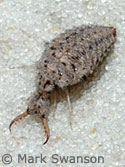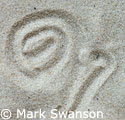Classification
Antlions are a family of insects given the zoological classification Myrmeleontidae. The name is rooted in the Greek words myrmex (ant) and leon (lion). The family Myrmeleontidae is part of the order Neuroptera, translated variously as "nerve wings," "net wings," or "sinew wings." All Neuroptera have four wings marked by a netlike pattern of veins. The order Neuroptera, which includes dobsonflies (subfamily Corydalinae) and lacewings (family Chrysopidae), is the most primitive order of insects with complete metamorphosis (Arnett 1985, 249).
Why are they called antlions?
The name "antlion" best
describes this insect's predacious larval
form—a mottled gray or brown creature with an oversized
head,
spiny jaws, short legs, and a soft body covered in bristles (see Figure 1).
 Figure 1. Antlion larva (Myrmeleon sp.). © 2005 Mark Swanson |
The larvae of some antlion species hide under bits of debris or wood and attack passing insects.
 Figure 3. Antlion adult (Myrmeleon sp.). © 2005 Mark Swanson |
 Figure 2. Sand "doodles" created by an antlion larva (Myrmeleon sp.). © 2005 Mark Swanson |
Adult antlions (Figure 3) resemble dragonflies or damselflies (order Odonata) and, like damselflies, they are feeble flyers (Arnett 1985, 260). Antlions are easily distinguished from Odonata by their longer, prominent, clubbed antennae and different type of wing venation (Arnett 1985, 250). Compared to other Neuroptera (e.g., lacewings), an antlion's antennae are shorter. The adult is seldom seen in the wild because it is active only in the evening; during the day it rests, motionless, well-camouflaged by its transparent wings and dusk body (Grzimek 1979, 224).
Size
For most North American species, fully developed larvae are as long as a human fingernail—about 1.5 cm (0.6 in.). Adults are approximately 4 cm (1.5 in.) long and have a wingspan of 8 cm (3.2 in.).
The largest forms are found in the predominately African genus Palpares; these have a wingspan of 16 cm (6.3 in.). A very small form in Arabia has a wingspan of only 2 cm (0.8 in.). The largest European species is Acanthaclisis occitanica, with a wingspan of 11 cm (4.3 in.). The other ten or so species native to central Europe are about a third smaller, and only half build sand traps (Grzimek 1979, 227).
Interrelationships with other animals
Of the documented relationships between antlions and other animals, perhaps the most interesting is the relationship in which antlion larvae serve as hosts to parasitic insects. For example, the larvae of the Australian horsefly Scaptia muscula live inside antlion larvae pits, where they share the spoils of the antlions' trapping abilities (Ramel 1995).
A species of chalcid wasp, Lasiochalcidia igiliensis, is also an antlion parasite. The wasp provokes a host antlion larva into grabbing the parasite's legs in its mandibles, at which time the parasite oviposits into the membrane between the larva's head and thorax (Piek 2013, 73-74).
Antlions are often included in lists of beneficial insects, no doubt because they prey upon ants, a common pest to humans.
